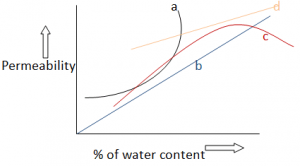This set of Casting, Forming and Welding Multiple Choice Questions & Answers (MCQs) focuses on “Green Sand Mould”.
1. In a green sand moulding process, uniform ramming leads to _____
a) uniform flow of molten into the mould cavity
b) less chance of gas porosity
c) less sane expansion type of casting defect
d) greater dimensional stability of the casting
View Answer
Explanation: Uniform ramming of sand is very necessary for green sand moulding process. Uniform ramming of sand during mould preparation improves mould strength, and makes it dimensionally stable. Uniform ramming done to obtain a smooth and hard casting surface which prevents break out.
2. In green sand mould, what is the indication of the word green?
a) It shows polymeric mould has been cured
b) Mould is green in color
c) Mould contains moisture
d) Mould has been totally dried
View Answer
Explanation: Green sand mould contains 3-6 % of water, due to containing of moisture it is termed as green sand. Green sand has enough strength so that the constructed mould retains its shape. Moisture makes the sand more feasible and 95% reusable.
3. Which of the following is not a property of a sand mould?
a) Fluidity
b) Strength
c) Collapsibility
d) Permeability
View Answer
Explanation: Fluidity is the property of molten metal, which is used to describe the capability of the molten metal to fill mould cavities. Solidification interval, viscosity and surface tension are the factors which help in determining the fluidity of the molten metal.
4. Hardness of green sand mould can be increase by _____
a) increase in permeability
b) decrease in permeability
c) increase in moisture content beyond 6 percent
d) increase in both moisture content and permeability
View Answer
Explanation: A decrease in permeability usually indicates a closed structure in the rammed sand, and if the decrease continues, it will lead to tighter packing and fewer voids hence increase in hardness of the green sand mould. This increase in hardness can be measured by mould hardness tester.
5. What is the advantage of having a low bulk density of a sand-mix?
a) Higher strength
b) Good refractoriness
c) Higher flow ability
d) Higher permeability
View Answer
Explanation: Low bulk density of sand mix results in equal size of grains with smooth round shape, this further results in increase in volume of voids due to less bulk density and hence a higher permeability which permits an easy outflow of the gases from the molten metal.
6. Which test is performed for the study of grain size distribution of moulding sand?
a) Screening test
b) Whirl test
c) Crushing test
d) Shearing test
View Answer
Explanation: Screening test is performed by taking a fixed sample weight of sand and screening it through standard sieves. It is accomplished by shaking the sieves. The amount of sand that collects in the different sieves is then plotted, and then a distribution of grain size is computed.
7. Which of the following reasons stand for the crumbling of green sand mould?
a) The sand grains are not adequately bonded
b) Excess of water and clay mixture
c) Due to the presence of impurities in the green sand mould
d) Fine grain size
View Answer
Explanation: Sand mould crumbles because moulding sand is not adequately compacted in the flask. Clay, together with water acts as a bonding agent and the organic additives also save the mould from crumbling by burning out at high temperatures and make room for the moulding sand to expand.
8. Refractoriness of the green sand mould shows _____
a) High strength
b) Toughness
c) High temperature resistant
d) High porosity
View Answer
Explanation: Refractoriness is the ability of the moulding material to withstand the high temperatures of the molten metal to be poured so that it does not get fused with the metal. The refractoriness of the silica sand is highest. Refractoriness is measured by the sinter point of the sand.
9. In the given below graph, which curve represents the permeability of the green sand mould with the % of the water content?

a) a
b) b
c) c
d) d
View Answer
Explanation: There is optimum water content for the permeability considerations. At a lower water content, dry clay powder, being finer than sand grains, fills up the voids between the sand particles, and thus reduces the permeability. Beyond the optimum water content, water itself fills up the voids and reduces the permeability.
10. Which of the following sands has the highest thermal conductivity?
a) Silica sand
b) Zircon sand
c) Chromite sand
d) Olivine sand
View Answer
Explanation: It has low coefficient of thermal expansion. Due to high density and high chilling power, zircon sand has high thermal conductivity. These properties of the zircon sand make it very useful in controlling zircon sand, which is used as refractory bedding material.
11. Bentonite is commonly used as bonding material for dry sand cores.
a) True
b) False
View Answer
Explanation: Bentonite is a type of clay which used as a bonding material because bentonite can absorb more water, which increases its bonding power, so that it can be used for drilling mud, purification and as a binder, absorbent, groundwater barrier etc.
Sanfoundry Global Education & Learning Series – Casting, Forming and Welding.
To practice all areas of Casting, Forming and Welding, here is complete set of 1000+ Multiple Choice Questions and Answers.
If you find a mistake in question / option / answer, kindly take a screenshot and email to [email protected]
- Check Mechanical Engineering Books
- Practice Metallurgical Engineering MCQs
- Practice Casting, Forming and Welding II MCQ
- Check Casting, Forming and Welding I Books
- Apply for Mechanical Engineering Internship
